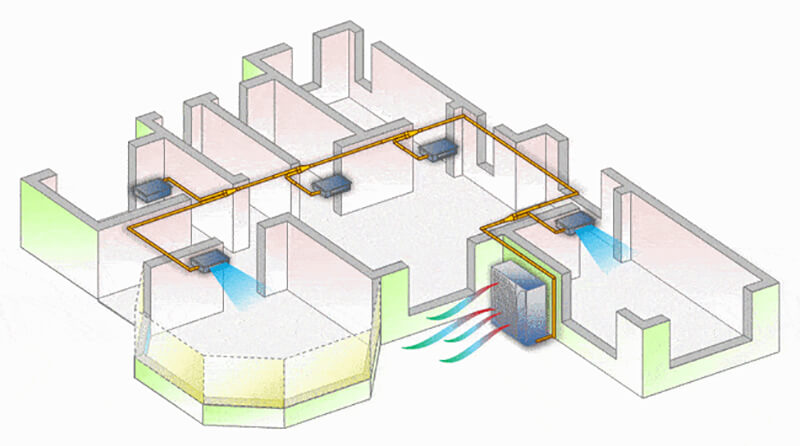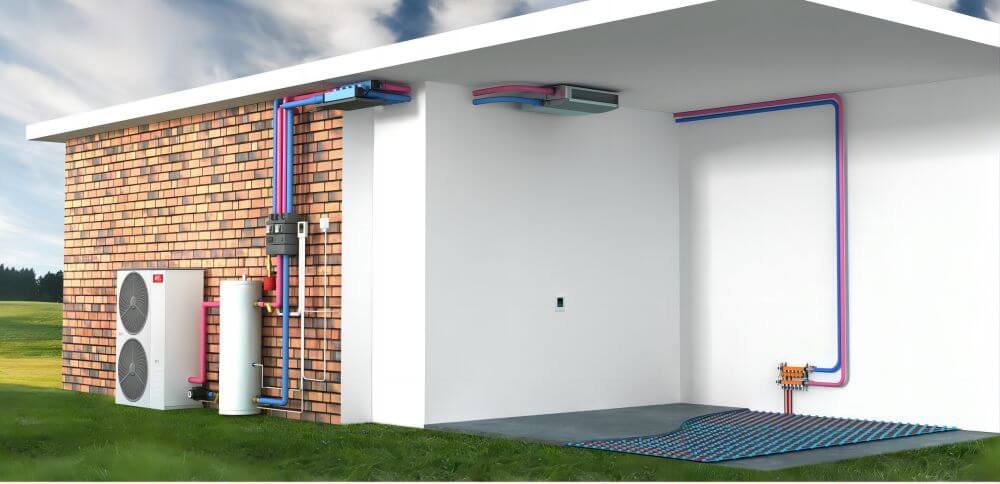Air ducts are piping systems used for the transport and distribution of air. They come in two types: composite air ducts and inorganic air ducts. Air ducts can be classified based on their cross-sectional shape and material.
Central air conditioning vents are terminal devices used for air supply and return within a central air conditioning system, serving as air distribution equipment. Supply vents deliver cooled or heated air indoors, while return vents draw indoor polluted air back, creating a complete air circulation cycle. This not only ensures the effectiveness of indoor cooling and heating but also maintains the cooling quality and comfort of indoor air.
The size of the vents depends on the capacity of the indoor unit. If the outlet is too large or the duct is too long, the airflow speed will decrease, affecting the air conditioning’s effectiveness. Conversely, if the outlet is too small, the airflow speed will increase, causing discomfort from air blowing directly on the body and potentially leading to excessive noise.

1. Air Speed within Ducts
For general air-conditioned rooms, the noise level of the air conditioning system is controlled between 40 to 50 dB (A), corresponding to NR (or NC) numbers between 35 to 45 dB (A). According to design standards, the permissible noise levels dictate main duct air speeds of 4 to 7 m/s and branch duct air speeds of 2 to 3 m/s. For ducts between ventilators and silencers, an air speed of 8 to 10 m/s can be adopted.
2. Calculation of Air Outlet Size
To prevent noise at the vents, the airspeed at supply vents should ideally be 2 to 5 m/s. The calculation of vent sizes is fundamentally similar to that of duct sizes. Typically, for rooms with a floor height of 3 to 4 meters, an air speed of 2 to 2.5 m/s is selected.
3. Suction Speed at Return Vents
When return vents are located at the upper part of a room, a suction speed of 4 to 5 m/s is used. For return vents at the lower part of the room, if they are not close to areas where people frequently stay, a speed of 3 to 4 m/s is chosen; if they are near such areas, a lower speed of 1.5 to 2 m/s is preferred. For corridors used for return air, a speed of 1 to 1.5 m/s is adequate.
4. Air Duct Installation Considerations and Calculations
Ensure that, while minimizing the duct design, the main duct air speed is maintained at 5 m/s, and the branch duct air speed at 3 m/s.
Duct Calculation Formula
- Formula for Air Duct Calculation: The selected equipment’s air volume ÷ 3600 ÷ air speed = duct cross-sectional area. Additionally, ensure the duct ratio: long side ÷ short side ≤ 4; generally, do not exceed 4, and treat special cases especially.
- Selection of Vents: The selected room’s air volume ÷ 3600 ÷ air speed = diffuser throat cross-sectional area. Note: For double-louvered vents, the cross-sectional area is the area obtained from the above formula ÷ 0.7.
5. Calculating Duct Sizes
1. The Equal Friction Method (Constant Pressure Method) is a convenient calculation method suitable for various occasions.
2. Determine the basic friction coefficient in the main duct according to the following:
| Types of Duct | Friction Coefficient(mmH20) |
| Supply Duct | 0.05-0.2 |
| Return Duct | 0.03-0 12 |
Due to the return duct being located at the suction part and mainly bearing external pressure, attention should be paid to reducing its duct burden. For duct systems, commonly used:
- Supply Duct: 0.08 to 0.15 mm H2O / m;
- Return Duct: 0.06 to 0.1 mm H2O / m as a baseline.
6. Duct Design for Air Handling Units
When designing ductwork for air handling units, it is important to install static pressure boxes at the inlet and outlet to balance the air pressure, reduce noise, and ensure that the flow velocity within the static pressure box is maintained at 3 m/s or below. The length of the static pressure box can be determined based on the actual situation.
7. Estimating Air Pressure
- Losses in simpler duct configurations (with fewer elbows, tees, and size changes) result in a loss of about 4 pa per meter.
- Losses in more complex duct configurations (with more elbows, tees, and size changes) result in a loss of about 6 pa per meter.
8. Design of Air Vents for Fan Coil Units
- The distance between the first supply vent and the outlet of the fan coil unit should be appropriate.
- The distance between the supply and return vents of the fan coil unit should also be appropriate (≤5 meters).
9. Selection of Vents
- Fresh air and supply vents should use double-layer louvered vents.
- Return air vents should use grille vents.
- Exhaust vents should use double-layer louvers.
- For fluorine systems, which generally have a smaller air volume and may require heating in winter, double-layer louvers are suitable; diffusers are not recommended.
Table 1: Recommended Air Flow Speeds for Supply Vents
| Application Places | Flow speed (m/s) |
| Studio | 1.5~2.5 |
| Theater | 2 5-3.5 |
| Houses, Apartments, Hotel rooms, Classrooms | 2.5-3.8 |
| Private office | 2.5~4.0 |
| General Office | 5.0-6.0 |
| Cinema | 5 |
| Department store, Upper floor | 7.5 |
| Department store, Underground | 10 |
If you want to know more, please click below:
- Grilles, Registers & Diffusers – The Ultimate Guide
- HVAC Linear Slot Diffusers – The Ultimate Guide
- HVAC Egg Crate Diffuser – The Ultimate Guide
- HVAC Jet Nozzle Diffuser – The Ultimate Guide
- HVAC Linear Bar Grilles – The Ultimate Guide
- HVAC Air Swirl Diffusers – The Ultimate Guide
- HVAC Round Ceiling Diffusers – The Ultimate Guide
- Round Ceiling Diffusers – The Ultimate Guide
- Exhaust Air Louver – The Ultimate Guide
- HVAC Registers – The Ultimate Guide


